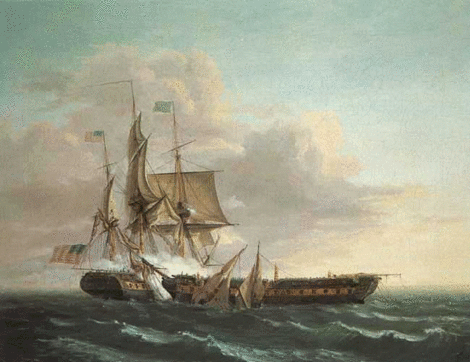Annotation:Hull's Victory (1)
X:1 T:Hull's Victory [1] M:C| L:1/8 K:F fc fa fc fg|ag fe f2AB|c2cd c2cB|AB GA F2c2| fc fa fc fa|g2g2g2ag|fe dc =Bc dB|c2e2c2c2:| |:fe fg ag fe|d2B2B2ef|g^f ga ba g=f|e2c2c2 (3cde| fc fa fc fa|gc gb gc gb|ag fa gf eg|f2a2f2c2:||
HULL'S VICTORY [1] (Buaid Mic Uill). New England; Hornpipe and reel. USA; Maine, New Hampshire, New York. F Major (Brody, Burchenal, Cole, Ford, Linscott, Miller & Perron, Phillips, Sweet, White): D Major (O'Neill, Shaw, Sweet). Standard tuning (fiddle). One part (Burchenal): AABB (most versions): AA'BB (Phillips). This title commemorates Hull's victory off the coast of Nova Scotia in the War of 1812. An American hero, Captain Isaac Hull was commander of the frigate USS Constitution ('Old Ironsides'), which engaged the British frigate HMS Guerriere under Captain Richard Dacre in fierce combat in the Gulf of St. Lawrence, about 750 miles out of Boston. The battle lasted 55 minutes and left 101 dead. With the Guerriere dismasted and smashed beyond salvage, Captain Dacre struck his colors and surrendered to Hull's boarding party. The Constitution, heavier and more solidly built, suffered little damage and only 14 casualties. The impact of the clash, however, was to shock the British Admiralty and hearten America and the fledgling American Navy in the dark days of the War of 1812.

Captain Hull was honored with a hornpipe or reel that has maintained currency through the years, “Hull’s Victory,” which must have been composed soon after his victory off the coast of Nova Scotia in August, 1812. The melody is similar to an old English drinking song and a Scottish dance tune, according to Simon Bronner (Old Time Music Makers of New York State, 1987), and started life as a ballad, though soon entered enduring popular tradition as a dance tune, which he insists is one of the earliest contra dance melodies composed in America. The tune was in general circulation among amateur musicians in the ten years following Hull's victory, as evidenced by its appearance in printed song sheets and musicians' manuscripts such as H. Canfield copybook of music for his flute (Hartford, Conn., 1823) and fifer Ebenezer Bevens' commonplace book (Middletown, Conn., 1825). Paul Wells, of the Center for Popular Music/Middle Tennessee State University, has found an untitled version in a fife manuscript begun in 1807 (entered later than that date).
”Hull’s Victory,” both tune and contra dance, can be traced through the years quite nicely in print. Dance instructions were recorded in the Essex Manuscript of c. 1830, and in Elias Howe’s American Dancing Master (Boston, 1862), while the melody was printed in Howe's Musician's Companion, Part 1 (Boston, 1842). Elizabeth Burchenal printed the dance and tune in her American Country Dances (1918), and Eloise Hubbard Linscott (Folk Songs of Old New England, 1939) confirms the popularity if both. Contra dance maven Ralph Page reported it was a favorite dance in New Hampshire until the early 1900's, and still was being danced in Washington Country, Vermont, in the mid-20th century. Page himself led its revival among new generations of New England contra dancers. Henry Ford’s champion fiddler, Mellie Dunham, of Norway, Maine, had a different, but very danceable, tune he called “Hull’s Victory”, which he recorded in 1926.
Although strongly associated with New England, “Hull’s Victory” managed to escape regional boundaries. The reel was entered into the large 19th century music manuscript collection[1](No. 226, p. 63) of prosperous dairy farmer, miller, sometime printer and bookbinder, and fiddler James Barry (1819-1906) of Six Mile Brook, Pictou County, northern Nova Scotia, who probably copied it from one of the Elias Howe Co. publications. The title also appears in a list of traditional Ozark Mountain fiddle tunes compiled by musicologist/folklorist Vance Randolph, published in 1954. Lloyd Shaw, in his book Cowboy Dances (1943), writes:
It would shock my New England friends to hear an old Colorado Rancher ask me if I ever danced Hell's Victory. From his description I was sure of the dance and told him it was Hull's Victory, not Hell's- Hull's Victory with his famous ship The Constitution. "No, no!" he says, "it's Hell's Victory! Called it that ever since I was a boy!"
There is a report (which needs to be verified) that the tune can be found in the 9th violin sonata, 4th movement of Italian Baroque composer Arcangelo Corelli, published c. 1695-1700, also in the key of B-Flat.

